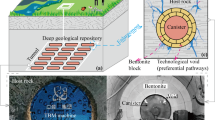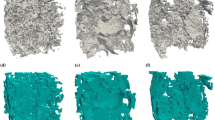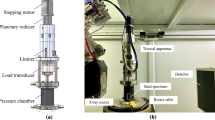Abstract
Although freeze–thaw damage to rocks has been extensively studied in recent decades, the quantitative correlation between the microscopic pores and macroscopic physico-mechanical properties of rocks under freeze–thaw action has not yet been determined. In this study, the pore structure variation in three sandstones during the freeze–thaw process was continuously measured by the mercury intrusion porosimetry (MIP) test. The pore size distribution can be characterized by a multimodal exponential function. With increasing freeze–thaw cycles, the characteristic pore radii of the nanopores (d ≤ 5 × 10−5 mm), micropores (5 × 10−5 mm ≤ d ≤ 0.1 mm), and macropores (0.1 mm ≤ d ≤ 1 mm) increase. However, the volumetric fractions of nanopores and micropores decrease continuously during freeze–thaw cycles because a considerable number of nanopores and micropores develop into macropores. The fractal dimension of the pore structure gradually decreases as the number of freeze–thaw cycles increases. This implies that the pore size distribution gradually tends to be more homogeneous and that the complexity of the pore structure decreases. Finally, the relationship between microscopic pore structure parameters and macroscopic properties (porosity, P-wave velocity, and uniaxial compressive strength) was established. Through the analysis of microscopic structure evolution and loss of macroscopic properties, it can be concluded that the growth of macropores may play a dominant role in freeze–thaw damage and strength loss. This study can provide a better understanding of the macro-microscopic freeze–thaw damage mechanism of sandstones.




























(Modified by Zhang et al. 2022)
Similar content being viewed by others
Data availability
The data used to support the findings of this study are available from the corresponding author upon request.
Abbreviations
- UCS :
-
Uniaxial compressive strength (unit: MPa)
- n,n 0 :
-
Porosity and initial porosity of sandstone, respectively
- ρ d :
-
Density of dry sandstone (unit: kg/m3)
- ρ w :
-
Density of water (unit: kg/m3)
- V p sa , :
-
P-wave velocity for sandstone (unit: m/s)
- V s :
-
The volume of a sandstone sample (unit: m3)
- E m :
-
Elastic modulus for saturation sandstone (unit: GPa)
- m sa(N), m d(N):
-
Completely saturated and dry masses of sandstones after Nth freeze–thaw cycles, respectively (unit: g)
- \({p}_{\text{c}}\) :
-
Capillary pressure (unit: MPa)
- \(\sigma\) :
-
Surface tension of mercury (unit: N)
- \(\theta\) :
-
Wetting contact angle between the mercury and pore wall of rocks (unit: °)
- k :
-
Peak point number of the increment curve of mercury inlet
- F(r):
-
Cumulative pore fraction
- V 1, V 2, V 2.1, V 2.2, V 3 :
-
Volumetric fractions of nanopores, micropore, fine micropores, coarse micropores, and macropores, respectively
- D f :
-
Fractal dimension
- m 1, m 2, m 2.1, m 2.2, m 3 :
-
Characteristic pore radii of nanopores, micropore, fine micropores, coarse micropores, and macropores, respectively (unit: mm)
- D 1, D 2, D n :
-
The diameter of throat pores (unit: mm)
- V 1 ink, V 2 ink, V n ink :
-
The volume of ink-bottle pores
- V m1 ink, V m2 ink, V mn ink :
-
The volume of residual mercury in ink-bottle pores
- r :
-
Pore radius (unit: mm)
- d :
-
Pore diameter (unit: mm)
- N(r):
-
Number of pores larger than r
- N f :
-
Number of freeze–thaw cycles
- a :
-
An undetermined coefficient
- V Hg :
-
Accumulated mercury volumetric for the pores
- l :
-
Pore length (unit: mm)
- j :
-
Peak point number of the increment curve of mercury intrusion
- MIP:
-
Mercury intrusion porosimeter
- SEM:
-
Scanning electron microscope
- NMR:
-
Nuclear magnetic resonance
- XRD:
-
X-ray diffraction
- CT:
-
Computer tomography
- AE:
-
Acoustic emission
- BET:
-
Brunauer–Emmett–Teller
References
Ahmadi S, Ghasemzadeh H, Changizi F (2021) Effects of a low-carbon emission additive on mechanical properties of fine-grained soil under freeze-thaw cycles. J Clean Prod 304:127157. https://doi.org/10.1016/j.jclepro.2021.127157
Amirkiyaei V, Ghasemi E, Faramarzi L (2020) Determination of P-wave velocity of carbonate building stones during freeze–thaw cycles. Geotech Geol Eng 38:5999–6009. https://doi.org/10.1007/s10706-020-01409-z
ASTM (2010) D7012-10 Standard test method for compressive strength and elastic moduli of intact rock core specimens under varying states of stress and temperatures, in Annual Book of ASTM Standards, ASTM International, West Conshohocken, PA
Deprez M, Kock TD, Schutter GD, Cnudde V (2020) A review on freeze-thaw action and weathering of rocks. Earth-Sci Rev 203:103143. https://doi.org/10.1016/j.earscirev.2020.103143
Diamond S (2000) Mercury porosimetry: an inappropriate method for the measurement of pore size distributions in cement-based materials. Cem Concr Res 30:15171525. https://doi.org/10.1016/S0008-8846(00)00370-7
Fan LF, Xu C, Wu ZJ (2020) Effects of cyclic freezing and thawing on the mechanical behavior of dried and saturated sandstone. Bull Eng Geol Environ 79:755–765. https://doi.org/10.1007/s10064-019-01586-z
Fogue-Djombou YI, Corn S, Clerc L, Salze D, Garcia-Diaz E (2019) Freeze-thaw resistance of limestone roofing tiles assessed through impulse vibration monitoring and finite element modeling in relation to their microstructure. Constr Build Mater 205:656–667. https://doi.org/10.1016/j.conbuildmat.2019.01.211
Folk RL (1980) Petrology of sedimentary rocks. Hemphill publishing company, Austin, Tex
Gao ZY, Hu QH (2013) Estimating permeability using median pore-throat radius obtained from mercury intrusion porosimetry. J Geophys Eng 10(2):025014. https://doi.org/10.1088/1742-2132/10/2/025014
Garzanti E (2019) Petrographic classification of sand and sandstone. Earth-Sci Rev 192:545–563. https://doi.org/10.1016/j.earscirev.2018.12.014
Ghoreishian Amiri SA, Grimstad G, Kadivar M (2022) An elastic-viscoplastic model for saturated frozen soils. Eur J Environ Civ En 26(7):2537–2553. https://doi.org/10.1080/19648189.2016.1271361
Grubeša IN, Marković B, Vračević M, Tunkiewicz M, Szenti I, Kukovecz Á (2019) Pore structure as a response to the freeze/thaw resistance of mortars. Materials 12(19):3196. https://doi.org/10.3390/ma12193196
Hu WL, Cheng WC, Wen SJ, Rahman MM (2021) Effects of chemical contamination on microscale structural characteristics of intact loess and resultant macroscale mechanical properties. CATENA 203:105361. https://doi.org/10.1016/j.catena.2021.105361
Huang SB, Liu QS, Liu YZ, Ye ZP, Cheng AP (2018) Freezing strain model for estimating the unfrozen water content of saturated rock under low temperature. Int J Geomech 18:04017137. https://doi.org/10.1061/(ASCE)GM.1943-5622.0001057
Huang SB, Lu ZX, Ye ZY, Xin ZK (2020a) An elastoplastic model of frost deformation for the porous rock under freeze-thaw. Eng Geol 278:105820. https://doi.org/10.1016/j.enggeo.2020.105820
Huang SB, Ye YH, Cui XZ, Cheng AP, Liu GF (2020b) Theoretical and experimental study of the frost heaving characteristics of the saturated sandstone under low temperature. Cold Reg Sci Technol 174:103036. https://doi.org/10.1016/j.coldregions.2020.103036
Huang SB, He YB, Liu GF, Lu ZX, Xin ZK (2021a) Effect of water content on the mechanical properties and deformation characteristics of the clay-bearing red sandstone. Bull Eng Geol Environ 80:1767–1790. https://doi.org/10.1007/s10064-020-01994-6
Huang SB, He YB, Liu XW, Xin ZK (2021b) Experimental investigation of the influence of dry-wet, freeze-thaw and water immersion treatments on the mechanical strength of the clay-bearing green sandstone. Int J Rock Mech Min 138:104613. https://doi.org/10.1016/j.ijrmms.2021.104613
Huang SB, Cai C, Yu SL, He YB, Cui XZ (2022a) Study on damage evaluation indexes and evolution models of rocks under freeze-thaw considering the effect of water saturations. Int J Damage Mech 31:10567895221106240. https://doi.org/10.1177/10567895221106
Huang SB, He YB, Yu SL, Cai C (2022b) Experimental investigation and prediction model for UCS loss of unsaturated sandstones under freeze-thaw action. Int J Min Sci Technol 32:41–49. https://doi.org/10.1016/j.ijmst.2021.10.012
Huang SB, Yu SL, Ye YH, Ye ZY, Cheng AP (2022c) Pore structure change and physico-mechanical properties deterioration of sandstone suffering freeze-thaw actions. Constr Build Mater 330:127200. https://doi.org/10.1016/j.conbuildmat.2022.127200
Huang SB, Liu F, Liu G, Yu SL (2023) Estimation of the unfrozen water content of saturated sandstones by ultrasonic velocity. Int J Min Sci Techno 33(6):733–746. https://doi.org/10.1016/j.ijmst.2023.02.003
Jia HL, Xiang W, Krautblatter M (2015) Quantifying rock fatigue and decreasing compressive and tensile strength after repeated freeze-thaw cycles. Permafrost Periglacial Process 26:368–377. https://doi.org/10.1002/ppp.1857
Jia HL, Ding S, Zi F, Dong YH, Shen YJ (2020) Evolution in sandstone pore structures with freeze-thaw cycling and interpretation of damage mechanisms in saturated porous rocks. CATENA 195:104915. https://doi.org/10.1016/j.catena.2020.104915
Jin SS, Zheng GP (2020) A micro freeze-thaw damage model of concrete with fractal dimension. Constr Build Mater 257:119434. https://doi.org/10.1016/j.conbuildmat.2020.119434
Kaneuji M, Winslow DN, Dolch WL (1980) The relationship between an aggregate’s pore size distribution and its freeze-thaw durability in concrete. Cem Concr Res 10(3):433–441. https://doi.org/10.1016/0008-8846(80)90119-2
Khanlari G, Abdilor Y (2015) Influence of wet-dry, freeze-thaw, and heat-cool cycles on the physical and mechanical properties of upper red sandstones in central Iran. Bull Eng Geol Environ 74:1287–1300. https://doi.org/10.1007/s10064-014-0691-8
Kjelstrup S, Ghoreishian Amiri SA, Loranger B, Gao H, Grimstad G (2021) Transport coefficients and pressure conditions for growth of ice lens in frozen soil. Acta Geotech 16:2231–2239. https://doi.org/10.1007/s11440-021-01158-0
Li JL, Kaunda RB, Zhou KP (2018) Experimental investigations on the effects of ambient freeze-thaw cycling on dynamic properties and rock pore structure deterioration of sandstone. Cold Reg Sci Technol 154:133–141. https://doi.org/10.1016/j.coldregions.2018.06.015
Liu B, Ma YJ, Liu N, Han YH, Li DY, Deng HL (2019) Investigation of pore structure changes in Mesozoic water-rich sandstone induced by freeze-thaw process under different confining pressures using digital stone technology. Cold Reg Sci Technol 161:137–149. https://doi.org/10.1016/j.coldregions.2019.03.006
Liu CJ, Deng HW, Chen XM, Xiao DJ, Li B (2020) Impact of rock samples size on the microstructural changes induced by freeze-thaw cycles. Rock Mech Rock Eng 53(11):5293–5300. https://doi.org/10.1007/s00603-020-02201-4
Liu TY, Zhang CY, Li JT, Zhou KP, Ping C (2021) Detecting freeze-thaw damage degradation of sandstone with initial damage using NMR technology. Bull Eng Geol Environ 80:4529–4545. https://doi.org/10.1007/s10064-021-02242-1
Mandelbrot BB (1982) The fractal geometry of nature. WH Freeman, New York
Meng FD, Zhai Y, Li YB, Zhao RF, Li Y, Gao H (2021) Research on the effect of pore characteristics on the compressive properties of sandstone after freezing and thawing. Eng Geol 286:106088. https://doi.org/10.1016/j.enggeo.2021.106088
Niu CY, Zhu ZM, Zhou L, Li XH, Ying P, Dong YQ, Deng S (2021) Study on the microscopic damage evolution and dynamic fracture properties of sandstone under freeze-thaw cycles. Cold Reg Sci Technol 191:103328. https://doi.org/10.1016/j.coldregions.2021.103328
Ondrášik M, Kopecký M (2014) Rock pore structure as main reason of rock deterioration. Stud Geotech Mech 36:79–88. https://doi.org/10.2478/sgem-2014-0010
Park J, Hyun CU, Park HD (2015) Changes in microstructure and physical properties of stones caused by artificial freeze-thaw action. Bull Eng Geol Environ 74:555–565. https://doi.org/10.1007/s10064-014-0630-8
Qu JJ, Cheng GD, Zhang KC, Wang JC, Zu RP, Fang HY (2007) An experimental study of the mechanisms of freeze/thaw and wind erosion of ancient adobe buildings in northwest China. Bull Eng Geol Environ 66:153–159. https://doi.org/10.1007/s10064-006-0040-7
Song YJ, Tan H, Yang HM, Chen SJ, Che YX, Chen JX (2021) Fracture evolution and failure characteristics of sandstone under freeze-thaw cycling by computed tomography. Eng Geol 294:106370. https://doi.org/10.1016/j.enggeo.2021.106370
Sun Y, Zhai C, Xu JZ, Cong YZ, Qin L, Zhao C (2020) Characterisation and evolution of the full size range of pores and fractures in rocks under freeze-thaw conditions using nuclear magnetic resonance and three-dimensional X-ray microscopy. Eng Geol 271:105616. https://doi.org/10.1016/j.enggeo.2020.105616
Tan XJ, Chen WZ, Liu HY, Wang LY, Ma W, Chan AHC (2018) A unified model for frost heave pressure in the rock with a penny-shaped fracture during freezing. Cold Reg Sci Technol 153:1–9. https://doi.org/10.1016/j.coldregions.2018.04.016
Ulusay R, Hudson JA (2007) The complete ISRM suggested methods for rock characterization, testing and monitoring. ISRM Commission on Testing Methods, Ankata. 1974–2006
Uranjek M, Bokan-Bosiljkov V (2015) Influence of freeze-thaw cycles on mechanical properties of historical brick masonry. Constr Build Mater 84:416–428. https://doi.org/10.1016/j.conbuildmat.2015.03.077
Wang P, Xu JY, Liu S, Wang HY, Liu SH (2016) Static and dynamic mechanical properties of sedimentary stone after freeze-thaw or thermal shock weathering. Eng Geo 210:148–157. https://doi.org/10.1016/j.enggeo.2016.06.017
Wang P, Xu JY, Fang XY, Wang PX (2017) Energy dissipation and damage evolution analyses for the dynamic compression failure process of red-sandstone after freeze-thaw cycles. Eng Geol 221:104–113. https://doi.org/10.1016/j.enggeo.2017.02.025
Wang YJ, Han JQ, Li CH (2020) Acoustic emission and CT investigation on fracture evolution of granite containing two flaws subjected to freeze-thaw and cyclic uniaxial increasing-amplitude loading conditions. Constr Build Mater 260:1–14. https://doi.org/10.1016/j.conbuildmat.2020.119769
Weng L, Wu ZJ, Taheri A, Liu QS, Lu H (2020) Deterioration of dynamic mechanical properties of granite due to freeze-thaw weathering: considering the effects of moisture conditions. Cold Reg Sci Techno 176:103092. https://doi.org/10.1016/j.coldregions.2020.103092
Yao YB, Liu DM (2012) Comparison of low-field NMR and mercury intrusion porosimetry in characterizing pore size distributions of coals. Fuel 95:152–158. https://doi.org/10.1016/j.fuel.2011.12.039
Zeng Q, Chen S, Yang PC, Peng Y, Wang JY, Zhou CS, Wang ZD, Yan DM (2020) Reassessment of mercury intrusion porosimetry for characterizing the pore structure of cement-based porous materials by monitoring the mercury entrapments with X-ray computed tomography. Cem Concr Compos 113:103726. https://doi.org/10.1016/j.cemconcomp.2020.103726
Zeng L, Wang LS, Xu HX, Jiao GN, Cui SN, Han H, Zhang BS (2010) SY/T 5163–2010, Analysis method for clay minerals and ordinary non-clay minerals in sedimentary rocks by the x-ray diffraction, Beijing China: Petroleum Industry Publishing House. (In Chinese)
Zhang Y, Wu K, Yang ZX, Ye G (2022) A reappraisal of the ink-bottle effect and pore structure of cementitious materials using intrusion-extrusion cyclic mercury porosimetry. Cem Concr Res 161:106942. https://doi.org/10.1016/j.cemconres.2022.106942
Zhou J, Ye G, Van-Breugel K (2010) Characterization of pore structure in cement-based materials using pressurization-depressurization cycling mercury intrusion porosimetry (PDC-MIP). Cem Concr Res 40:1120–1128. https://doi.org/10.1016/j.cemconres.2010.02.011
Zhou CY, Liang N, Liu Z (2020) Multifractal characteristics of pore structure of red beds soft rock at different saturactions. J Eng Geo 28(1):1–9. https://doi.org/10.13544/j.cnki.jeg.2018-337
Funding
This work was supported by National Natural Science Foundation of China (Grant No. 42371374, No. 42072300 and No. 41702291), Project of Natural Science Foundation of Hubei Province (Grant No. 2021CFA094). This work was supported by “The 14th Five Year Plan” Hubei Provincial advantaged characteristic disciplines (groups) project of Wuhan University of Science and Technology (Grant No. A0303).
Author information
Authors and Affiliations
Corresponding author
Ethics declarations
Conflict of interest
The authors declare no competing interests.
Rights and permissions
Springer Nature or its licensor (e.g. a society or other partner) holds exclusive rights to this article under a publishing agreement with the author(s) or other rightsholder(s); author self-archiving of the accepted manuscript version of this article is solely governed by the terms of such publishing agreement and applicable law.
About this article
Cite this article
Yu, S., Huang, S., Liu, F. et al. Quantification of pore structure evolution and its correlation with the macroscopic properties of sandstones under freeze–thaw action. Bull Eng Geol Environ 83, 3 (2024). https://doi.org/10.1007/s10064-023-03484-x
Received:
Accepted:
Published:
DOI: https://doi.org/10.1007/s10064-023-03484-x




